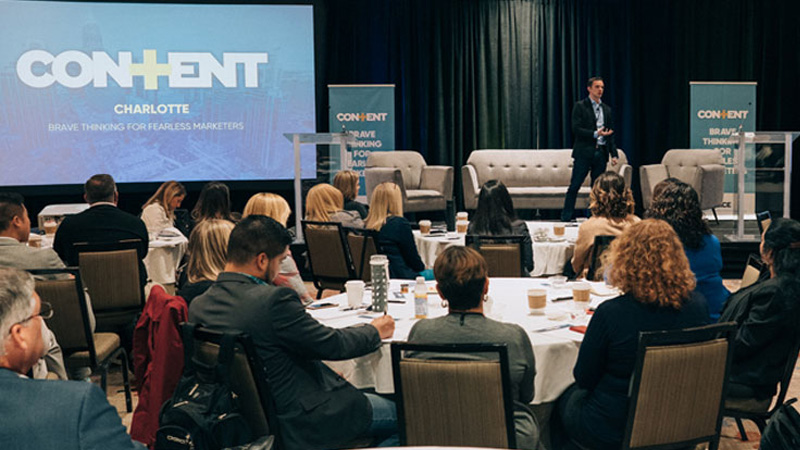Navigating The Road
The mind of a creative person is uncharted territory. Never ones for the beaten path, creatives prefer to explore parts unknown in search of inspiration and insight. Each one has his or her own way of generating ideas, and we can all learn a little something from these unique thinkers. Because whether you’re drafting a proposal or crafting a video, creativity is absolutely essential.
However, channeling creativity can be difficult for many of us. It requires dynamic thought, an innovative spirit, and a visionary mind. It is an ongoing process that, when fully mined, can yield amazing results. So how can you do what the creatives do?
We tapped the minds of three visionaries-painter Peter Campbell, video producer Brian Bowen, and photographer Dana Neibert-to ask them what goes into their creative processes and how it influences their work.
The Individual Creative Process:
Peter Campbell probably isn’t wrong in believing that he could have had a successful career as a photographer. After taking photography classes in high school, he presented a portfolio of his work to the head of the photo department at the prestigious Savannah College of Art and Design. The man briefly examined one of Campbell’s photos and quickly offered him a scholarship to attend the school.
But what happened after Campbell enrolled says everything about him as an artist and his approach to the creative process. Though he had a natural talent for photography, Campbell became obsessed with painting, even though he says he could barely draw a stick figure.
“I was fascinated [that] you could learn to do this,” he says. “I realized that I like learning more than I like anything else. I think discovery and learning is what spurs an artist.”
A Personal Path
Since he began painting, Campbell has been on an endless journey of learning, discovering, and creating. From his home in rural Colorado, Campbell paints evocative landscapes and portraits that appear in galleries and in private collections in North America and Europe. But the restlessness and self-critique Campbell brings to his craft is something that creative people in any profession would do well to emulate as it fuels his creative process.
“I’m only as good as my last painting,” he says. “I have to always be trying to one-up myself. I do that by constantly learning.”
Part of what Campbell had to learn is that creativity and the creative process cannot be purely objective. When he first started painting, Campbell would sometimes drive for hours and hours looking for just the right landscape to use as a subject. Now, he’s far more interested in capturing a deeper meaning-more a feeling than a mirror image-of a place. This involves both close observation and introspection.
“I have taken reality, looked at it, filtered it, and put my own emotional context to it,” he says. “The end result is a compromise between the reality of what I saw and the embodiment of who I am.”
No Maps (or Pot Roast) Allowed
Campbell has also come to understand that there is no one creative process that anybody should try to follow; it’s not a road map or a recipe for pot roast. There are still times when he’ll spot a subject and know instinctively that it’s worth painting.
“I can see something and say, ‘Oh, there it is,’” he says. “‘There’s my composition, there’s my light, and this is what it says.’”
But there are also times when he paints subjects based solely on memory and imagination.
“I make paintings out of my head because I’ve lived a life of experience,” he says.
Campbell is comfortable with uncertainty and ambiguity; they’re a natural part of the creative process. He controls what he can—like his technical skills and the time he puts into his craft—but he accepts that he still has plenty to learn.
“It’s not only learning how to see, but it’s learning a sense of taste,” he says. “That takes time, and it can be done, but it takes passion. I still feel like I’m on the upper end of amateur. I don’t see an end to my learning how to paint.”
While Campbell may have a lot to learn about painting, when it comes to creativity in general, he has learned that sometimes you have to step out of your comfort zone and embrace the unknown.
The Collaborative Creative Process:
Long before he even knew what it was, Brian Bowen was a student of the creative process. Growing up in Cincinnati, Bowen diligently observed the operation of his grandfather’s photography studio, Marsh Brand Partners, which largely serviced the Ohio-based corporate giant Procter & Gamble.
“I knew that my grandfather made a good living playing with cameras and that it was fun, and he was happy,” says Bowen, who today uses one of his grandfather’s handmade lightbox cameras as a nightstand in his bedroom.
It came as no surprise that Bowen decided to follow his grandfather’s lead in pursuing a creative career, first as an actor (he appeared on the TV series 7th Heaven) and now behind the camera as an executive producer at Pace, where he leads the agency’s video practice. Having spent his life in the creative arts, Bowen has developed strong opinions about how marketers can generate and execute the compelling ideas and memorable content that brands need to forge lasting relationships with customers.
Sometimes Less Is More
While collaboration can be an important part of the creative process and lead to the birth of powerful ideas, Bowen says his experience has highlighted the need to limit the number of people participating in brainstorming sessions.
“There is almost a mathematical equation to the number of people that can be involved to seed a clear, crafted idea,” he says. Bowen notes, however, that there can be multiple groups charged with generating new ideas, so long as each group is limited to two or three people.
“I just don’t think you need 14 art directors and 12 writers,” he says. “It’s human nature that they all want to be right, and that can screw up and dilute a great idea.”
Job titles do not correlate to creativity anyway, Bowen says. Painters can come up with great stories, and writers can conceive stirring images. Bowen encourages those he works with to draw upon their creative pursuits and experiences outside of work. The lesson: Those who lead teams of creative people need to actively demolish labels.
“Find out what people are passionate about, and push them to be real creatives and get the most out of their talent,” says Bowen. “Don’t pigeonhole them.”
Finding Creativity Wherever It Lives
In addition, Bowen believes it’s the duty of creative marketers to challenge the limiting preconceptions clients may have about what content actually is. Words, photos, and video can all be effective content, but that’s just the start.
“I recently saw a street-art mural, and it changed colors and showed the inside of a human body,” he says. “That is content. We can do that. Why can’t an infographic live on a wall in Brooklyn?”
Just as important as the form content takes is whether or not it solves a client’s directive, such as raising brand awareness or driving sales. Ultimately, the creative process begins and ends with the client’s needs. Bowen advises marketers to remember that they are stewards.
“Clients are trusting us with their brand, and they’re funding us to execute creative ideas that other people will hopefully want to consume and enjoy or be affected by in a positive way,” he says. “We have to remember to be grateful for that opportunity.”
In Bowen’s opinion, small group collaboration and unconventional thinking inspires creative work that will also satisfy the client-the foundation of his creative process.
The Organic Creative Process:
Dana Neibert’s high school guidance counselors can take some of the blame for his relatively late start as a professional photographer. Growing up in northern California, Neibert’s love for all things mechanical got him interested in cameras and photography, but his counselors never considered the idea of photography as a career.
“I think maybe my high school did a crappy job of career guidance,” Neibert laughs. “I had no idea you could make a living as a photographer.”
He knows now. The San Diego-based commercial photographer’s clients include American Express, Four Seasons Hotels and Resorts, and Princess Cruises. To be sure, the demand for his services is due to his knack for capturing lush yet realistic images. But it probably doesn’t hurt that his winding route to becoming a sought-after photographer and the development of his creative process included a stint as a professional Jet Ski racer and, more importantly, time spent as an art director at an advertising firm.
“I’ve always had an art director’s eye, so that helps when I’m working and composing images,” he says. “I also know the politics of the agencies and have sympathy for art directors, because there are so many hands in the creative process and they need to please a lot of people.”
Let Instinct Be Your Guide
Neibert’s creative process melds collaboration and his own natural instinct, resulting in somewhat spontaneous creation. Though every commercial job is different, Neibert says he often needs to be in a shoot’s location before he knows what elements will make for a compelling visual narrative.
“It’s mostly intuitive,” he says. “If I’m going to shoot something, a lot of the time I don’t know what I’ll do until I’m there. Sometimes I’ll look at other images that have been done in the same location, but mostly I show up, look around, and say, ‘OK, this is going to make the great image.’ Then I go out with my camera and document it as I see it.”
While he trusts his instincts, Neibert still appreciates the creative input of art directors or creative directors while on set.
“Having an extra pair of eyes with me, if they are good with visual stuff, is good, because they may see something I’m missing,” he says. “It’s great to collaborate.”
Taking Creative Liberty
That same trust in others also explains Neibert’s approach to directing talent. A lot of the work he’s hired to do intends to capture real, unscripted moments. When he directs actors in his shoots, Neibert tries to give them little more than the most basic direction. This is another part of his creative process. He trusts the actors to allow the scene to unfold naturally.
“You give them the story and the direction and let them run with it,” he says. “If it’s a dad and a boy in a field or something, they will do things that are natural in a few minutes. You can’t script it to have them look at each other or smile in a certain way. If you just let them run with it, you’ll usually have a great shot in just a few minutes.”
For Neibert, the creative process is all about trust: in yourself, in the individuals you’re collaborating with and in the fact that your vision will succeed.
Where The Creative Process Begins
A notable similarity between these three artists is the fact that each started off in one creative realm and ended up in another. Campbell went to school to be a photographer but found he was a painter at heart. Bowen’s calling transitioned from on screen to behind the scenes. Neibert went from racing Jet Skis to snapping pictures of them.
This shows how the creative process-much like driving without GPS-requires exploration, probing, getting a little lost and learning from those wrong turns to find your way back.
No matter where these stories end, each one began the same way-with inspiration. Whether that inspiration came in the form of drawing stick figures, playing with a lightbox camera or studying mechanics, each artist found something they were passionate about, and that is where their creative processes began.






